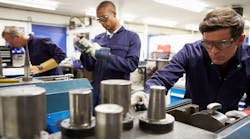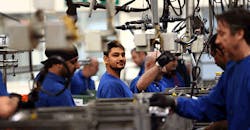It’s impossible to escape from the continuous marketing about agile business philosophies. Whether it’s a highly structured program with flowcharts for every situation, something exotic imported from faraway lands or a plan based on simply jettisoning everything and making it up as you go, the overall idea is the same. An agile business is, among other things, one that attempts to operate with minimal waste (continuous reductions of inefficiencies) and, perhaps most importantly, can respond to problems and leverage opportunities more quickly.
With such obvious advantages to be had by adopting an agile business philosophy it’s curious that companies across the board ignore the most agile resource in the workplace: the employees.
Nowhere is this more true than in manufacturing. It’s easy to pick on the U.S. manufacturing sector, but failure to acknowledge the value of employees is common behavior in managing labor heavy companies. That said, above all others it’s manufacturing that makes the most noise in promoting the agile business concept, while simultaneously despairing at the paucity of suitable workers.
How U.S. manufacturing got here is something for boring college classes of the future. Right now getting out of this situation is where we must focus our attentions. Happily, there is a way out. Best of all, we’ve already tested it and found it incredibly effective and it doesn’t have to cost manufacturers anything. That’s not to say there’s no cost involved, just that it’s not something manufacturers have to pay for.
The proven solution to many of the woes befallen by human resources managers at factories across America is the universal teaching of core vocational skills throughout primary education. That was the seldom discussed secret weapon of the U.S. manufacturing sector during World War II. Everything had to happen fast, work well, and was subject to change on a daily basis. Because everyone shared a basic body of knowledge it made continuous reassignment of workers to most any task a viable option that simultaneously broadened workforce capabilities as people were regularly exposed to new tasks.
People like to say that modern manufacturing has become too complex for those without advanced education to have a place. I respond that while the technology has advanced, the knowledge and skills gap between workers and their jobs has never been smaller. In 1940, 64% of Americans 18 and older did not have a complete high school education. That’s a staggering number of people who were effectively illiterate and had little knowledge of arithmetic beyond absolute basics. The mass of uneducated people also included women who, up until that decade, often didn’t leave the house except to go to the grocery store and church. Yet those same people were cranking out aircraft, munitions, some of the largest construction projects ever seen and operating the electromagnetic and gaseous diffusion plants that would fuel the first nuclear weapons. Yep, in those famous pictures of women operating the calutrons in the Y-12 plant at ORNL could not read past an early grammar school level. Even more impressive, all those knobs and gauges on those calutrons actually controlled the process.
Jumping back to the present, more than a few machines in modern plants don’t have much beyond Start, Stop and Emergency Stop buttons. Those that do have more complex interfaces are almost entirely equipped with screens and teach pendants with multiple layers of computerized oversight routines to prevent operators from wrecking them. Operating modern manufacturing equipment has never been easier or more well suited to people who already know technology, which is most people born in the last 30 years or so.
The same thing applies with every other aspect of modern manufacturing; the equipment and processes are more complex, but the gap between those things and operators, MRO folks, janitorial and safety people is small. They’re texting away using technology that’s more advanced than the machines they’re responsible for.
So why can’t today’s manufacturers find workers?
Unfortunately, it’s not a function of trade policies or economic barriers or race, gender, creed, religion, age or any of those easy issues. Manufacturers can’t find employees in large part because we’ve created two generations of the least educated people possible. It’s almost impossible to find entry-level workers who can actually use a tape measure.
Before you start sending angry emails, I challenge you to point to two random places on a tape measure and ask your kids to calculate the distance between them and to find the center between them without using a calculator (or phone). If they can do it (I’m giving my audience the benefit of the doubt that if they’re reading NED, they can also read a tape measure) then ask them to divide the distance into multiple proportional sections using Phi (no calculators). Ask your kid’s friends to do it too. Then ask how many of them want to be designers and engineers. Then ask yourself if that’s who you want designing the things you enjoy and rely on for continuity of your life. I certainly don’t want that and I simply can’t hire people who haven’t mastered the basics.
I’ve done that experiment as a guest lecturer with kids studying education in their last semester at university, and it’s been horrifying. I don’t do those lectures anymore because one hour isn’t long enough to delve into basic concepts. This is elementary stuff and they should have learned it in elementary school, not at the last minute before heading off to teach the next generation of kids whatever it is they’re teaching them — which doesn’t seem to include the knowledge our grandparents and great grandparents learned without the benefit of going to school.
You can teach and train people to use specific technologies later in life, but if they don’t understand the basics and know how to apply them, then that person is of limited value in the workplace.
But those who do know and understand those basics can leverage those things to advance their careers. Employers are the big winners here. Employees with core vocational skills can work in many different roles, put new eyes onto old problems, reduce turnover, provide the company with a workforce that’s capable of handling things which would otherwise require outside consultants and build a management team that knows everything about the business. It’s a win-win situation that we know works.
Students today don’t need an education in specific technologies; they’ve got that under control. They need to be taught the basics and then they’ll be able to shine as they develop new, exciting and profitable things when they start to combine tech with the fundamentals.













